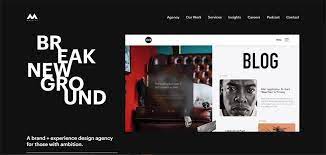Website Design and Marketing: A Symbiotic Relationship
In today’s digital age, a well-designed website is a crucial component of any successful marketing strategy. Website design and marketing are intricately linked, with each playing a pivotal role in attracting, engaging, and converting visitors into customers.
Effective website design goes beyond aesthetics; it encompasses user experience, functionality, and brand identity. A visually appealing website with intuitive navigation not only captivates visitors but also encourages them to explore further. By creating a seamless user journey, businesses can enhance engagement and build trust with their audience.
Moreover, a well-designed website serves as a powerful marketing tool. It acts as the online face of a brand, conveying its values, offerings, and unique selling points to potential customers. Through strategic placement of compelling content, calls-to-action, and visual elements, businesses can guide visitors towards desired actions, such as making a purchase or signing up for a newsletter.
Search engine optimisation (SEO) is another crucial aspect where website design and marketing converge. A well-optimised website not only ranks higher in search engine results but also attracts organic traffic from users actively seeking relevant products or services. By incorporating SEO best practices into the design process, businesses can improve their online visibility and reach a wider audience.
Furthermore, responsive design plays a key role in modern marketing strategies. With the proliferation of mobile devices, ensuring that a website is accessible and functional across various screen sizes is essential for engaging users on the go. Responsive design not only enhances user experience but also boosts search engine rankings, as search engines prioritise mobile-friendly websites in their results.
In conclusion, the relationship between website design and marketing is symbiotic: one cannot thrive without the other. By investing in thoughtful design that aligns with marketing objectives, businesses can create compelling online experiences that drive engagement, conversions, and ultimately business growth.
Top 5 Essential Tips for Effective Website Design and Marketing
- Ensure your website is visually appealing and user-friendly to attract and retain visitors.
- Optimize your website for search engines (SEO) to improve visibility and attract organic traffic.
- Create valuable and relevant content to engage visitors and establish your expertise in the industry.
- Utilize social media platforms to promote your website, engage with users, and drive traffic.
- Monitor website analytics regularly to track performance, identify areas for improvement, and make data-driven decisions.
Ensure your website is visually appealing and user-friendly to attract and retain visitors.
To maximise the effectiveness of your online presence, it is essential to ensure that your website is visually appealing and user-friendly. A well-designed website not only captures the attention of visitors but also creates a positive first impression that can lead to increased engagement and retention. By combining aesthetics with intuitive navigation and functionality, you can create a seamless user experience that encourages visitors to explore further and return for future interactions. Remember, a visually appealing and user-friendly website is not only a reflection of your brand but also a powerful marketing tool that can help attract and retain valuable customers.
Optimize your website for search engines (SEO) to improve visibility and attract organic traffic.
Optimising your website for search engines (SEO) is a fundamental step in enhancing visibility and attracting organic traffic. By strategically incorporating relevant keywords, meta tags, and high-quality content, you can improve your website’s ranking in search engine results pages. This not only increases the likelihood of users discovering your site but also establishes credibility and trust with both search engines and visitors. A well-executed SEO strategy can drive targeted traffic to your website, resulting in higher engagement, conversions, and ultimately, business success.
Create valuable and relevant content to engage visitors and establish your expertise in the industry.
Creating valuable and relevant content is a cornerstone of successful website design and marketing strategies. By offering visitors insightful information, expert advice, or engaging storytelling, businesses can not only capture the attention of their audience but also establish themselves as authorities in their industry. Quality content not only keeps visitors coming back for more but also helps build credibility and trust, ultimately driving conversions and fostering long-term relationships with customers.
Utilize social media platforms to promote your website, engage with users, and drive traffic.
To maximise the impact of your website design and marketing efforts, leverage social media platforms as powerful tools to promote your website, interact with users, and boost traffic. By actively engaging with your audience on platforms such as Facebook, Twitter, and Instagram, you can create a community around your brand, share valuable content, and drive visitors to your website. Social media not only enhances brand visibility but also provides a platform for building relationships with customers and fostering loyalty. Embrace the potential of social media to amplify your online presence and connect with a wider audience in a dynamic and interactive way.
Monitor website analytics regularly to track performance, identify areas for improvement, and make data-driven decisions.
Monitoring website analytics regularly is a crucial tip in website design and marketing. By tracking performance metrics such as traffic, engagement, and conversion rates, businesses can gain valuable insights into how their website is performing and how users are interacting with it. This data allows them to identify areas for improvement, pinpointing strengths and weaknesses in their online presence. By making data-driven decisions based on analytics, businesses can fine-tune their strategies, optimise user experience, and ultimately enhance their digital marketing efforts for greater success.

Leave a Reply